| Author |
Message |
|
Manouchehr M.
|
 Posted: Sat 23 Aug, 2003 4:52 pm Post subject: Middle Eastern Swords: Saif, Shamshir, Kilic Posted: Sat 23 Aug, 2003 4:52 pm Post subject: Middle Eastern Swords: Saif, Shamshir, Kilic |
 |
|
Hi everybody,
Let's get it on here! I am happy to be here and have the opportunity to talk about Middle Eastern swords. If you have any questions, please do not hesitate to ask.
Kilic is the general name for sword in Turkish
Saif is the general term for sword in Arabic
shamshir is the general term for sword in Persian
With tulwar we have a somehow clear structure although it can also be used for sword the same as pata. But well tulwar hilts all have dics and the general shape. They may come with a curved blade or with a Khanda blade. Let me start from the beginning.
There are different types of Turkish Kilic. But to begin with we will start with the two main ones.
In the west, Kilic is normally associated with a heavy sword with a strong back edge which is called "Yelman", this yelman gives the sword extreme cutting power, however, it might reduce the swiftness of sword movements in draw-cuts, a special swordmanship moves in Oriental swordmanship. Kilic are able to deliver devastating slashing cuts.
As we know this type of blade shape made its appearance around 1850. These are normally of twist core pattern, some with Turkish ribbon pattern. These patterns are comprised of twisted bars of hard and soft steel which are then forged together into a blade.
The blade shape and its T-spine is another characteristic and also a heavy yelman. Yelman will help in increasing the cutting ability, more penetration.
As you see the fittings are brass, earlier examples with Persian or Ottoman wootz blades with a narrow blade have iron fittings.
First example
By courtesy of Oriental Arms
"The Kilij is the traditional saber of the Ottomans. It was in use from the early 17 C. and during more than 300 years well into the 20th C. The shorter version with deeply curved wide blade and T spine is a later version and appeared in the mid 18 Century. This fantastic piece is probably late 19 C. The blade is 27 inches, well-curved and forged from superb pattern welded (Damascus) steel. The blade is decorated with gold koftgary inlay on both sides of the blade, showing an inscribed Arabic letters on one side and a six-point star on the other. Also the spine is beautifully inlaid with gold koftgari decoration. The classical hilt made of brass cross guard, horn grips and brass grip strap. The wood scabbard is leather covered and mounted with big brass locket and chape (Probably later to the sword). Excellent condition to its age. The blade has very few scratches and very minor stained spots on its back. The grips show some age crack and signs of old repairs. The cross guard was broken and re-soldered at some time and the brass strap is restored. Altogether an outstanding sword"
By courtesy of Oriental Arms
 Attachment: 39.13 KB Attachment: 39.13 KB
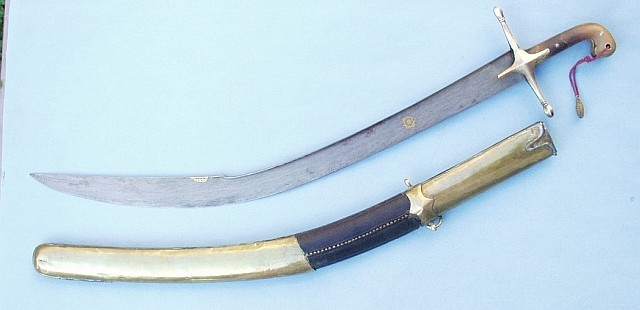
|
|
   |
 |
|
Manouchehr M.
|
 Posted: Sat 23 Aug, 2003 4:54 pm Post subject: Posted: Sat 23 Aug, 2003 4:54 pm Post subject: |
 |
|
Look at the beautiful pattern:
 Attachment: 88.19 KB Attachment: 88.19 KB
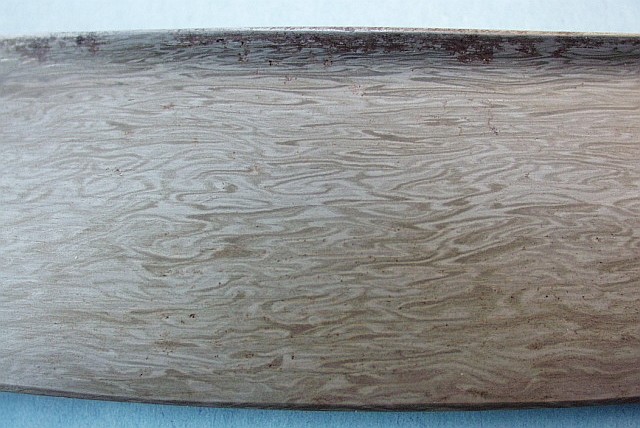
|
|
   |
 |
|
Manouchehr M.
|
 Posted: Sat 23 Aug, 2003 4:55 pm Post subject: Posted: Sat 23 Aug, 2003 4:55 pm Post subject: |
 |
|
Another example of late Kilic. Look at the golden overlay at the forte which is called Koftegari.
Example 2
The second example is really nice. Look at the pattern does this pattern have a special name?
By courtesy of Oriental Arms
"The Kilij is the traditional saber of the Ottomans. It was in use from the early 17 C. and during more than 300 years well into the 20th C. The shorter version with deeply curved wide blade and T spine is a later version and appeared in the mid 18 Century. This piece is early 19 C. and dated to 1226 (1811 in the Gregorian calendar). The blade is 27 inches long, well-curved with a pronounced 10 inches back edge and a T spine. It is forged from Turkish pattern welded steel (Damascus). The blade is decorated with gold koftgary inlay on both sides of the blade, and on the spine. The classical hilt made of brass cross guard, horn grips and brass grip strap. The wood scabbard is leather covered stitched with the correct spiral stitching and mounted with big brass locket and chape. Total length in scabbard 34 inches Very good condition to its age. The grips show some age crack and signs of old repairs. There are few dents in the brass mounts. All together a very impressive sword"
 Attachment: 39.21 KB Attachment: 39.21 KB

|
|
   |
 |
|
Manouchehr M.
|
 Posted: Sat 23 Aug, 2003 4:57 pm Post subject: Posted: Sat 23 Aug, 2003 4:57 pm Post subject: |
 |
|
Pattern
 Attachment: 56.69 KB Attachment: 56.69 KB
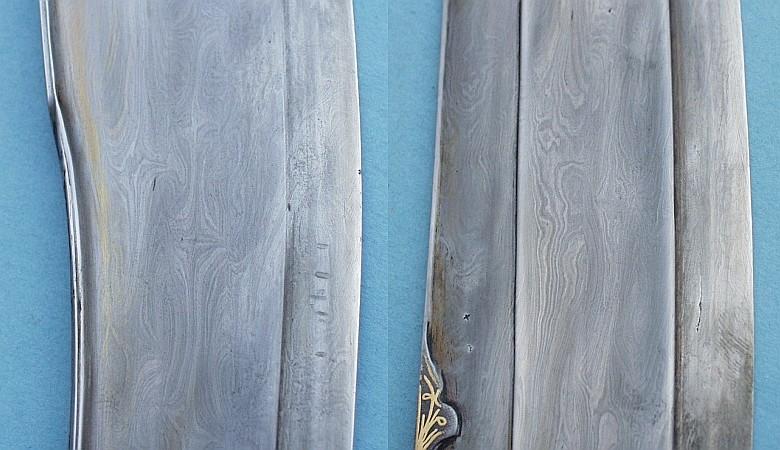
|
|
   |
 |
|
Manouchehr M.
|
 Posted: Sat 23 Aug, 2003 4:58 pm Post subject: Posted: Sat 23 Aug, 2003 4:58 pm Post subject: |
 |
|
Example 3
The pattern on this one does not look as nice as the others.
By courtesy of Oriental Arms
"The Kilij is the traditional saber of the Ottomans. It was in use from the early 17 C. and during more than 300 years well into the 20th C. The shorter version with deeply curved wide blade and ‘T’ spine is a later version and appeared in the mid 18 Century. This fantastic piece has a blade of 25 inches, well curved and forged from laminated steel folded at the blade tip. Although it is an 18 C. piece, the date of 1127 (1715) on the blade is not necessarily the blade date and it is a later addition probably done in the late 19 century to ‘upgrade’ the sword value. The blade spine is mounted with brass strips. The hilt of classical form is made of brass cross guard and rhino horn grips with bulbous pommel and brass grip strap. The wood scabbard is leather covered and mounted with big brass locket and chape. The condition is very good to its age. The blade has few scratches and stained spots. The grips pommel was broken and at some time in the recent years it was removed and re-mounted with added rivet. There are some dents to the scabbard fittings and the leather is worn and damaged. Altogether an outstanding sword
 Attachment: 30.97 KB Attachment: 30.97 KB
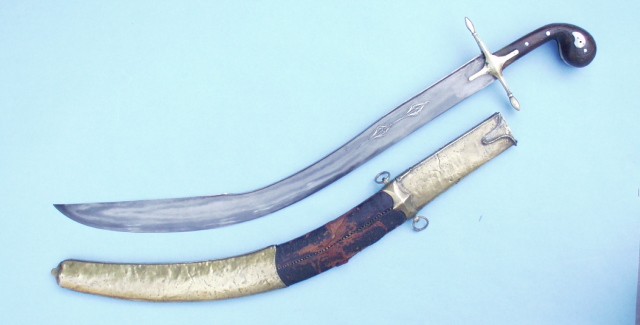
|
|
   |
 |
|
Manouchehr M.
|
 Posted: Sat 23 Aug, 2003 4:59 pm Post subject: Posted: Sat 23 Aug, 2003 4:59 pm Post subject: |
 |
|
Silver overlay (koftegari)
 Attachment: 54.04 KB Attachment: 54.04 KB
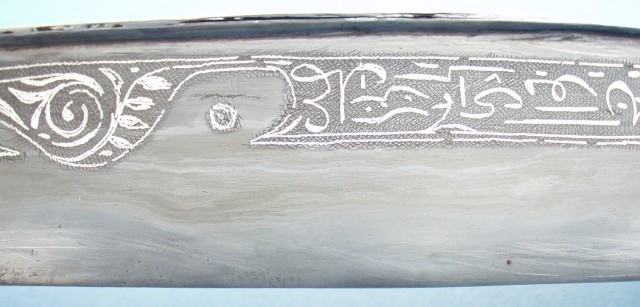
|
|
   |
 |
|
Manouchehr M.
|
 Posted: Sat 23 Aug, 2003 5:00 pm Post subject: Posted: Sat 23 Aug, 2003 5:00 pm Post subject: |
 |
|
Example four
By courtesy of Oriental Arms
This beauty has griaffe horn grips and Turkish twisted star blade
 Attachment: 44.32 KB Attachment: 44.32 KB
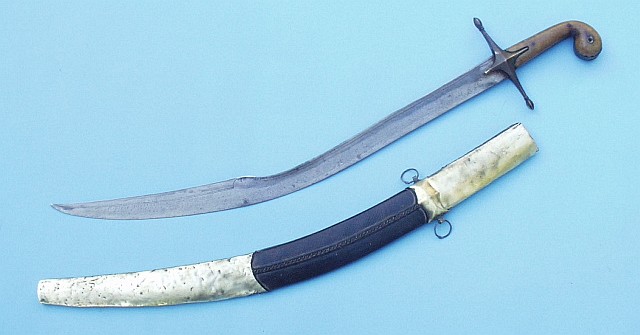
|
|
   |
 |
|
Manouchehr M.
|
 Posted: Sat 23 Aug, 2003 5:01 pm Post subject: Posted: Sat 23 Aug, 2003 5:01 pm Post subject: |
 |
|
Example four
By courtesy of Oriental Arms
This beauty has griaffe horn grips and Turkish twisted star blade
 Attachment: 52.69 KB Attachment: 52.69 KB
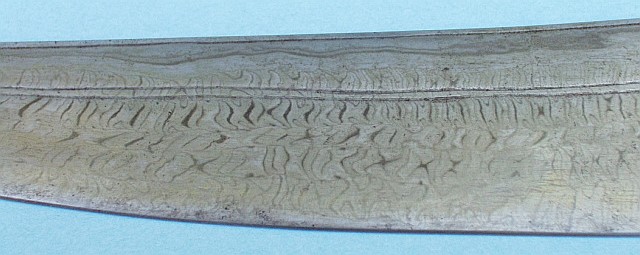
|
|
   |
 |
|
Manouchehr M.
|
 Posted: Sat 23 Aug, 2003 5:02 pm Post subject: Posted: Sat 23 Aug, 2003 5:02 pm Post subject: |
 |
|
example 5
Later they even come up with plain steel blades.
By courtesy of Oriental Arms
"This Turkish Kilij sword from the late 19 Century is a fine exemple of swords carried by high ranking officers of the Ottoman court. The blade is a classical 19 C. Kilij blade, relatively short, 26 inches long, wide and very curved with a pronounced T spine and a 9½ inches back edge. The blade is etched to imitate watering Damascus and decorated with gold koftgari inlay in Arabic inscription. The hilt and scabbard are of special decorative value: Gilded silver, with filigree work on the front face and chased on the rear face. It is richly set with many turquoise stones. Total length 38 inches. This sword come with a metal tag with the fig. 209, probably to indicate a catalog number of a museum or other important collection"
 Attachment: 51.15 KB Attachment: 51.15 KB
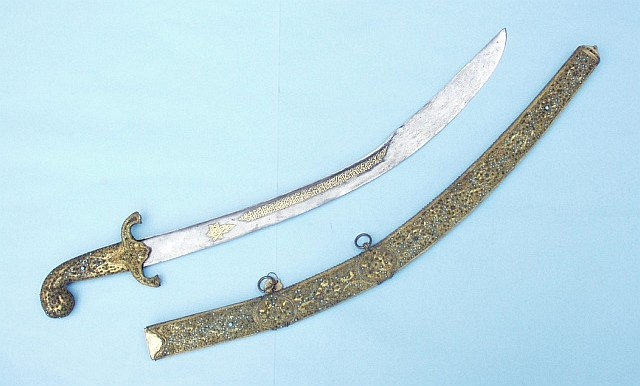
|
|
   |
 |
|
Manouchehr M.
|
 Posted: Sat 23 Aug, 2003 5:02 pm Post subject: Posted: Sat 23 Aug, 2003 5:02 pm Post subject: |
 |
|
Imitated false etched pattern
 Attachment: 63.2 KB Attachment: 63.2 KB
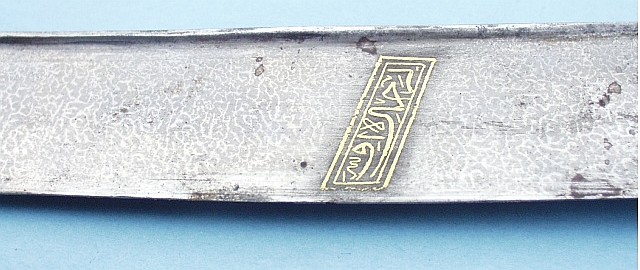
|
|
   |
 |
|
Manouchehr M.
|
 Posted: Sat 23 Aug, 2003 5:03 pm Post subject: Posted: Sat 23 Aug, 2003 5:03 pm Post subject: |
 |
|
This is the earlier form of Kilic also called Ottoman shamshir, this comes with a wootz blade.
This is an earlier Ottoman shamshir.
By courtesy of Oriental Arms
"This is a real beauty. The top of desire to the collectors of antique swords. A old, elegant wootz (Damascus) shamshir blade mounted with Turkish fittings. Blade is slender, wedge cross section, 29 ½ inches long (straight line). Rhino horn grips with clear fibrous structure, and ribbed on the pommel side. Engraved brass cross guard and grip strap. Wood scabbard with the original leather cover, stitched in the correct spiral stitching. Total length 36 inches. Very good blade condition. One side of the grips is cracked near the pommel but holds very solid. The original brass tip of the scabbard was replaced with a steel one long ago and the upper ring band is a replacement, A piece of great beauty and interest. "
 Attachment: 33.31 KB Attachment: 33.31 KB
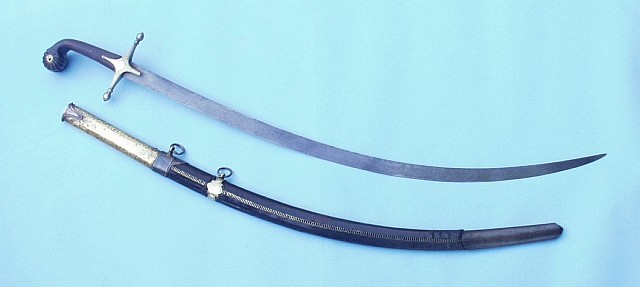
|
|
   |
 |
|
Manouchehr M.
|
 Posted: Sat 23 Aug, 2003 5:04 pm Post subject: Posted: Sat 23 Aug, 2003 5:04 pm Post subject: |
 |
|
Look at the wootz pattern
 Attachment: 47.58 KB Attachment: 47.58 KB
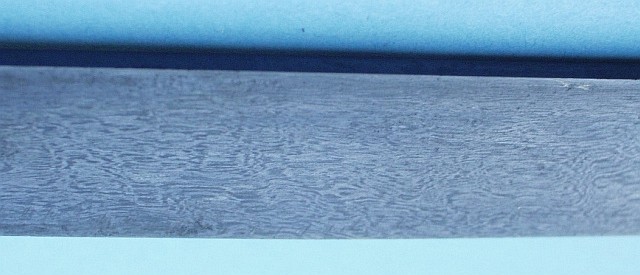
|
|
   |
 |
|
Manouchehr M.
|
 Posted: Sat 23 Aug, 2003 5:06 pm Post subject: Posted: Sat 23 Aug, 2003 5:06 pm Post subject: |
 |
|
Another example of late kilic with strong yelman
By courtesy of Hermann Historica
 Attachment: 19.64 KB Attachment: 19.64 KB
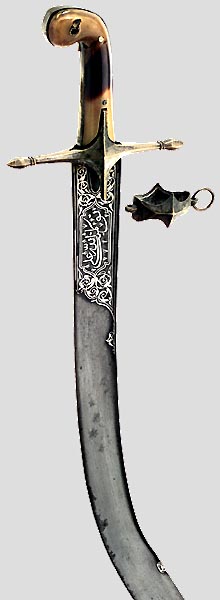
|
|
   |
 |
|
Manouchehr M.
|
 Posted: Sat 23 Aug, 2003 5:06 pm Post subject: Posted: Sat 23 Aug, 2003 5:06 pm Post subject: |
 |
|
Another late Kilic
By courtesy of Hermann Historica
 Attachment: 32.27 KB Attachment: 32.27 KB
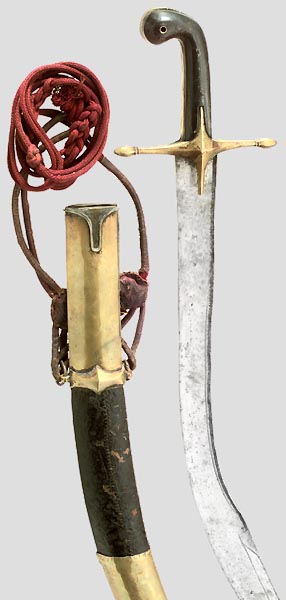
|
|
   |
 |
Thomas McDonald
myArmoury Alumni


|
 Posted: Sat 23 Aug, 2003 5:11 pm Post subject: Posted: Sat 23 Aug, 2003 5:11 pm Post subject: |
 |
|
Wonderful pic's & infomation , M ...... thank you !
See, I've learned some new things today *g* Mac
'Gott Bewahr Die Oprechte Schotten'
XX ANDRIA XX FARARA XX
Mac's PictureTrail
|
|
   |
 |
Nathan Robinson
myArmoury Admin


|
 Posted: Sat 23 Aug, 2003 11:30 pm Post subject: Posted: Sat 23 Aug, 2003 11:30 pm Post subject: |
 |
|
You have no idea how valuable posts like this are. My knowledge on this subject is really quite baseline in terms of depth. Every bit of information that comes in serves as foundation and almost always produces something completely new to me. I want to encourage you, and others, to continue to post introductory things like this. Having an interest for things like this makes me hungry to see more.
I also haven't had the exposure to the photos of these types of weaponry and love to see them. I'm a photo addict and really study the beautiful lines and etails of such things. There's certainly some amazing work to be seen here.
.:. Visit my Collection Gallery :: View my Reading List :: View my Wish List :: See Pages I Like :: Find me on Facebook .:.
|
|
    |
 |
|
Manouchehr M.
|
 Posted: Sun 24 Aug, 2003 1:11 am Post subject: Posted: Sun 24 Aug, 2003 1:11 am Post subject: |
 |
|
Thank you Mac and Nathan. This is an excellent board to get exposure to all readers.
Another early Kilic. As you can see this type has a Persian wootz blade. Ottomans were really fond of the quality of Persian blades and in their accounts they always feared the Persian swordman. Their advantage in battles was their artillery and msukets, the Safavid Persians in the fight of Chaldaran against Ottomans did not regard muskets and artillery as vaulable and honorable and relied on their swords and maces which led to their defeat.
An early Kilic
By courtesy of Hermann Historica
 Attachment: 8.04 KB Attachment: 8.04 KB

|
|
   |
 |
|
Manouchehr M.
|
 Posted: Sun 24 Aug, 2003 1:12 am Post subject: Posted: Sun 24 Aug, 2003 1:12 am Post subject: |
 |
|
Another early Kilic with Persian blade
By courtesy of Hermann Historica
 Attachment: 8.26 KB Attachment: 8.26 KB

|
|
   |
 |
|
Manouchehr M.
|
 Posted: Sun 24 Aug, 2003 1:24 am Post subject: Posted: Sun 24 Aug, 2003 1:24 am Post subject: |
 |
|
Persian shamshirs
The quality of Persian crucible steel was legendary in the region and everyone wanted to have one. As you see the blade arch is marvellous. These are vicious draw cutters and a pleasure to handle. Safavid Persians considered steel as holy and a true sign of manhood. Please note that in Iran in the holy book of Avesta 3000 years ago, steel/ iron is considered as a holy material.
By courtesy of Oriental Arms
"A Shamshir, the Eastern saber that for centuries enchanted the world and was copied in practically all armies of the western world. A light. Deeply curved, wedge shape blade of minimal and simple design and yet a lethal slashing weapon in the experienced hand. Here we offer for sale a classical example. A 31 inches blade forged from fantastic watered steel (Wootz, Damascus), steel cross guard, ivory grips and steel pommel. Total length 36 inches. Very good condition. Minor blackened areas on the blade and very few minor edge nicks. Very nice patina to the ivory grip with small age worn areas. No scabbard"
 Attachment: 31.89 KB Attachment: 31.89 KB
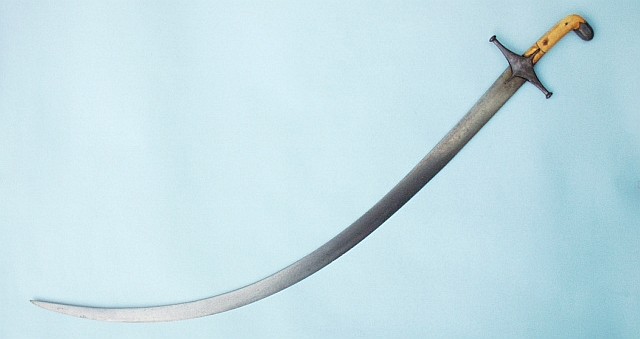
|
|
   |
 |
|
Manouchehr M.
|
 Posted: Sun 24 Aug, 2003 1:25 am Post subject: Posted: Sun 24 Aug, 2003 1:25 am Post subject: |
 |
|
This is a typical Persian grip
 Attachment: 59.7 KB Attachment: 59.7 KB
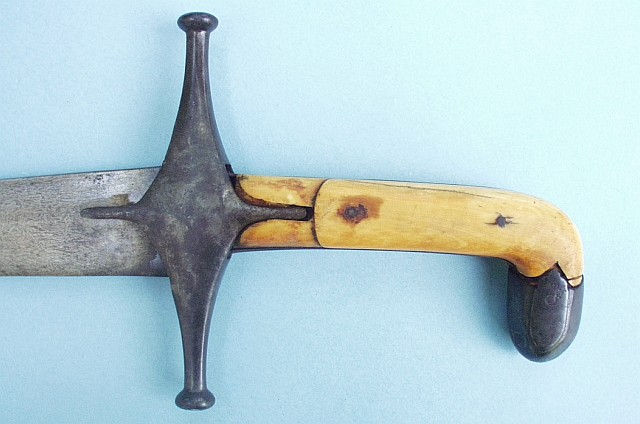
|
|
   |
 |
|
|

